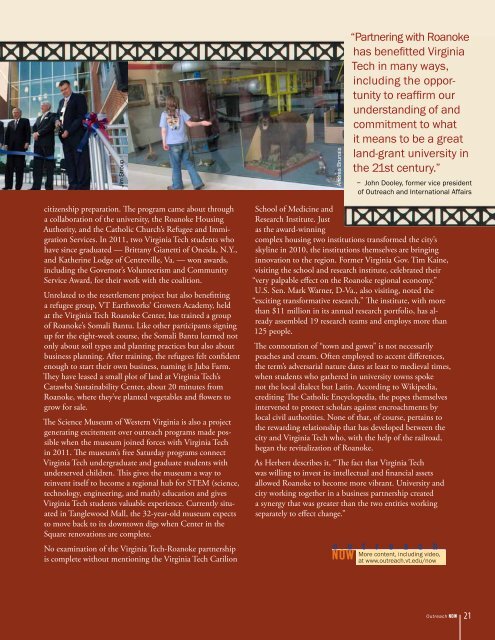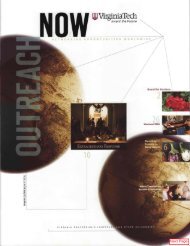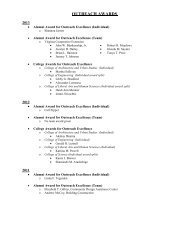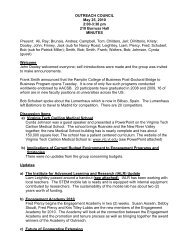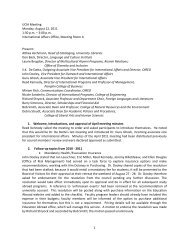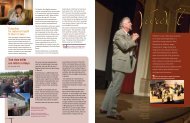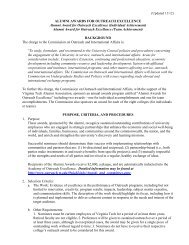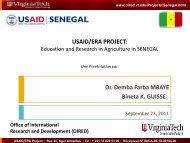2012â2013 Issue - Outreach & International Affairs - Virginia Tech
2012â2013 Issue - Outreach & International Affairs - Virginia Tech
2012â2013 Issue - Outreach & International Affairs - Virginia Tech
- No tags were found...
You also want an ePaper? Increase the reach of your titles
YUMPU automatically turns print PDFs into web optimized ePapers that Google loves.
Jim StroupAndrea Brunais“Partnering with Roanokehas benefitted <strong>Virginia</strong><strong>Tech</strong> in many ways,including the opportunityto reaffirm ourunderstanding of andcommitment to whatit means to be a greatland-grant university inthe 21st century.”– John Dooley, former vice presidentof <strong>Outreach</strong> and <strong>International</strong> <strong>Affairs</strong>citizenship preparation. The program came about througha collaboration of the university, the Roanoke HousingAuthority, and the Catholic Church’s Refugee and ImmigrationServices. In 2011, two <strong>Virginia</strong> <strong>Tech</strong> students whohave since graduated — Brittany Gianetti of Oneida, N.Y.,and Katherine Lodge of Centreville, Va. — won awards,including the Governor’s Volunteerism and CommunityService Award, for their work with the coalition.Unrelated to the resettlement project but also benefittinga refugee group, VT Earthworks’ Growers Academy, heldat the <strong>Virginia</strong> <strong>Tech</strong> Roanoke Center, has trained a groupof Roanoke’s Somali Bantu. Like other participants signingup for the eight-week course, the Somali Bantu learned notonly about soil types and planting practices but also aboutbusiness planning. After training, the refugees felt confidentenough to start their own business, naming it Juba Farm.They have leased a small plot of land at <strong>Virginia</strong> <strong>Tech</strong>’sCatawba Sustainability Center, about 20 minutes fromRoanoke, where they’ve planted vegetables and flowers togrow for sale.The Science Museum of Western <strong>Virginia</strong> is also a projectgenerating excitement over outreach programs made possiblewhen the museum joined forces with <strong>Virginia</strong> <strong>Tech</strong>in 2011. The museum’s free Saturday programs connect<strong>Virginia</strong> <strong>Tech</strong> undergraduate and graduate students withunderserved children. This gives the museum a way toreinvent itself to become a regional hub for STEM (science,technology, engineering, and math) education and gives<strong>Virginia</strong> <strong>Tech</strong> students valuable experience. Currently situatedin Tanglewood Mall, the 32-year-old museum expectsto move back to its downtown digs when Center in theSquare renovations are complete.No examination of the <strong>Virginia</strong> <strong>Tech</strong>-Roanoke partnershipis complete without mentioning the <strong>Virginia</strong> <strong>Tech</strong> CarilionSchool of Medicine andResearch Institute. Justas the award-winningcomplex housing two institutions transformed the city’sskyline in 2010, the institutions themselves are bringinginnovation to the region. Former <strong>Virginia</strong> Gov. Tim Kaine,visiting the school and research institute, celebrated their“very palpable effect on the Roanoke regional economy.”U.S. Sen. Mark Warner, D-Va., also visiting, noted the“exciting transformative research.” The institute, with morethan $11 million in its annual research portfolio, has alreadyassembled 19 research teams and employs more than125 people.The connotation of “town and gown” is not necessarilypeaches and cream. Often employed to accent differences,the term’s adversarial nature dates at least to medieval times,when students who gathered in university towns spokenot the local dialect but Latin. According to Wikipedia,crediting The Catholic Encyclopedia, the popes themselvesintervened to protect scholars against encroachments bylocal civil authorities. None of that, of course, pertains tothe rewarding relationship that has developed between thecity and <strong>Virginia</strong> <strong>Tech</strong> who, with the help of the railroad,began the revitalization of Roanoke.As Herbert describes it, “The fact that <strong>Virginia</strong> <strong>Tech</strong>was willing to invest its intellectual and financial assetsallowed Roanoke to become more vibrant. University andcity working together in a business partnership createda synergy that was greater than the two entities workingseparately to effect change.”o u t r e a c hNOWMore content, including video,at www.outreach.vt.edu/now<strong>Outreach</strong> NOW 21


